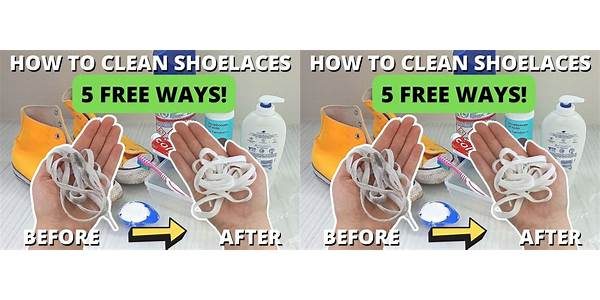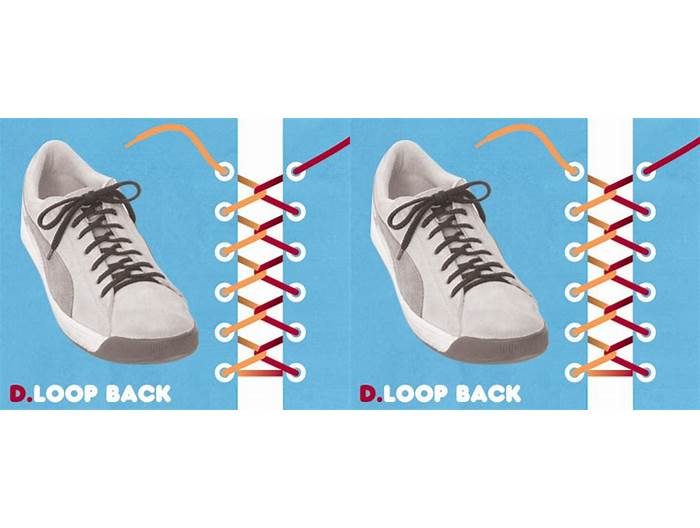Understanding the Problem: What Causes Shoelaces to Fray?
Shoelaces are one of those things that we rarely think about until they start to give us problems. One of the most common problems is fraying. The constant rubbing and pulling between the laces and the eyelets on your shoes can cause the fabric to wear down over time. Frayed shoelaces not only look unsightly but can also make it difficult to tie your shoes. This article provides you with the necessary steps to fix frayed shoelaces quickly and easily.
There are several reasons why shoelaces fray. One of the primary reasons is that the laces are made from synthetic materials that are not durable. Quality shoelaces must be made from sturdy, high-quality materials such as cotton, leather, and nylon, to resist wear and tear. The sturdier the material, the less likely the shoelaces will fray or break.
Another common problem that causes shoelaces to fray is how they are tied. If you tie your shoes too tightly, it can cause the laces to rub against the eyelets more, leading to fraying. Similarly, tying your shoes too loosely can cause the laces to move around excessively, causing fraying. Also, if you do not tie your laces correctly, the knots can wear away, causing the shoelaces to fray and break apart.
Finally, how shoes are worn can also cause laces to fray. Shoes that are too loose or too tight, or that rub against the ankle, can cause friction between the laces and the shoes, which accelerates fraying. In some instances, shoes with sharp eyelets or rough insides can also cause the shoelaces to fray prematurely.
Option 1: Re-tie and Re-lace: The Quick Fix
One of the easiest ways to fix frayed shoelaces is through the quick fix method of re-tying and re-lacing your shoes. This method is perfect for those who don’t have the time or the resources to replace their laces as it only requires a few minutes of your time.
The first step is to re-tie your shoelaces and make sure that they are secure and not prone to loosening up while you’re on the move. To do this, start by tying the lace as you normally would and then double knot it to ensure that it stays in place. Make sure that the knot is tight enough so that the laces don’t come undone while you’re walking.
If the frayed lace is beyond repair, you can opt to remove the damaged section by cutting it with a pair of scissors. After doing so, you can then use the remaining good length of the lace to re-lace your shoe. To re-lace, begin by threading the lace into the first pair of eyelets starting from the bottom going up. Make sure that the lace is even on both sides and tie it up.
Alternatively, you could also re-lace your shoes in a different way to avoid lacing through the damaged section. This method is perfect if the frayed part is located at the end of the lace. Start by threading the lace through the bottom eyelets, leaving out the damaged section, and then proceed to lace up the rest of the shoe as you normally would. This way, the damaged section is hidden inside the shoe and won’t be visible or get in the way.
In conclusion, re-tying and re-lacing your shoelaces is a quick and easy way to fix frayed shoelaces. Whether you opt to cut the damaged section or re-lace the shoe differently, be sure that the lace is tight, snug, and secure enough to prevent it from coming undone. Remember that this method is only a temporary fix and that you will eventually need to replace your laces in the long run.
Option 2: Cut and Burn: For Durable Laces
If you want to ensure that your shoelaces won’t fray again anytime soon, you can try this method. You’ll need a lighter, some scissors, and your frayed shoelaces. Keep the following in mind before getting started: this method will shorten your shoelaces a bit, so it’s best to use this technique on laces that are too long for your shoes or that can be easily replaced. Also, be careful when using fire and hot materials like lighters; make sure to do this in a well-ventilated area and keep a fire extinguisher nearby just in case.
Step 1: Cut the frayed part of the shoelace off at an angle. The angle will help the shoelace to thread through the eyelets of your shoes more easily later.
Step 2: Use the lighter to burn the end of the shoelace quickly, just enough to melt the fibers and prevent them from fraying again. Be sure to hold the lighter to the shoelace, not to the shoelace against a surface, to prevent scorch marks.
Step 3: Use your fingers to roll the melted end of the shoelace quickly into a tip. This will help the shoelace to thread through the eyelets more easily.
Step 4: Repeat steps 1 to 3 with the other end of the shoelace. Now, your shoelaces are ready to be used again. They’ll be slightly shorter, but they will also be less prone to fraying.
This method can work well for shoes that get a lot of wear and tear, like sneakers or running shoes. Some people prefer this method because it creates a small, hard tip on the end of the shoelace that can be easily threaded through the shoe’s eyelets. Others find it messy, time-consuming, or potentially dangerous, so it’s important to use common sense when trying this method.
If you’re looking for a way to make your shoelaces last longer, you can try using shoelace protectors, which are small plastic or silicone pieces that wrap around the ends of your shoelaces. These can prevent fraying and also help to keep your shoes looking clean and tidy. Shoelace protectors are easy to find online or in specialty shoe stores, and they come in a variety of colors and styles to match your shoes and personal style.
Whichever method you choose, fixing frayed shoelaces is a simple and cost-effective way to extend the life of your shoes. Whether you decide to tie, knot, or cut and burn your shoelaces, make sure to keep them clean and dry to prevent further wear and tear.
Option 3: Replace and Upgrade: Trying Different Types of Shoelaces
If you are tired of fixing frayed shoelaces, it might be time to replace them with a better quality upgrade. While traditional cotton and nylon laces are a common choice, there are other materials that can provide different benefits for your shoes.
Elastic laces, for example, are a popular and convenient option for people who want to save time during the lacing process. They can be easily stretched and secured with a lock, eliminating the need to tie and untie knots every time you wear your shoes. Additionally, elastic laces can adjust to your foot shape and provide a more comfortable fit than rigid laces.
Another material to consider is waxed laces. These laces are treated with wax to make them more durable, water-resistant, and attractive. They do not easily fray or tangle, and they stay tied for longer periods. Since waxed laces come in a variety of colors and thicknesses, you can easily match them with your shoes and personal style.
Leather laces are also a stylish and sturdy option for dress shoes and boots. They are resistant to wear and tear, and they have a nice texture and shine that complements leather materials. Leather laces are available in natural and dyed varieties, and they can last for a long time if properly maintained with leather conditioner.
For athletic shoes and outdoor activities, you may want to try special laces made from synthetic fibers like Kevlar or Dyneema. These laces are exceptionally strong and flexible, and they can withstand harsh conditions like extreme heat, cold, and abrasion. They also prevent stretching and slipping, which can be a safety hazard in certain sports or environments.
Finally, if you want to express your creativity or support a cause, you can try laces with different colors, patterns, or messages. There are shoelaces with rainbow stripes to symbolize LGBT pride, with breast cancer awareness ribbons, with national flags, and with various logos and slogans. By choosing these laces, you can show your personality, values, and affiliations.
In conclusion, replacing and upgrading your shoelaces can be a simple yet effective way to enhance the appearance, comfort, and functionality of your shoes. By trying different types of shoelaces, you can find the ones that best suit your needs and preferences, and enjoy a hassle-free and fashionable shoe experience.
Preventative Measures: Tips for Keeping Your Shoelaces from Fraying Again

After repairing your frayed shoelaces, you would not want to see them in that condition ever again. It means that you need to have a few preventive measures to ensure that your shoelaces are in tip-top shape. Here are some tips to prevent your shoelaces from fraying again:
Contents
1. Using high-quality shoelaces
One of the most common reasons for shoelaces to fray is that they are made of low-quality materials. To prevent this from happening, make sure that you buy high-quality shoelaces when you need to replace them. High-quality shoelaces will last longer and stay in better condition than low-quality ones.
2. Waxing your shoelaces

Waxing your shoelaces is another great way to prevent fraying. Applying a thin layer of wax on your shoelaces will prevent them from getting damaged easily. To wax your shoelaces, you can use a candle or a block of beeswax. Rub the wax on your shoelaces until they are covered with a thin layer of wax. After this, your shoelaces will be more resistant to wear and tear and last longer.
3. Tying your shoelaces correctly
The way you tie your shoelaces can also have an effect on how fast they fray. Make sure that you tie your shoelaces correctly every time you wear your shoes. Tying them too tight can cause the fibers to break, while tying them too loose can cause them to rub against each other. The correct way to tie your shoelaces is to do it neither too tight nor too loose.
4. Cleaning your shoelaces

Keeping your shoelaces clean is also essential for preventing them from fraying. The dirt and grime that accumulates on your shoelaces can cause them to break down faster. Therefore, it is essential to clean your shoelaces regularly. To clean your shoelaces, you can use a soft-bristled brush and a mild detergent or washing powder. After cleaning, rinse them thoroughly with water and air dry.
5. Alternating your shoelaces

Regularly alternating your shoelaces is another way to make them last longer and prevent fraying. This is because the way you tie your shoelaces will always be the same, causing wear and tear on the same areas. Therefore, it is good to switch between a few pairs of shoelaces so that they wear evenly. As long as you store them properly in a clean and dry place, alternating between different shoelaces will make your shoes look fantastic always.
These preventative measures can help you maintain your shoelaces so that they are always in excellent condition and do not fray. Implementing these tips can also help you save money on buying new shoelaces frequently. With these measures, you can keep your shoes looking good for a long time.

